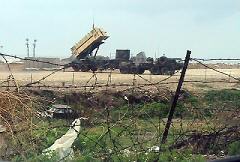

|
At the time, there was great trepidation about the possibility of Scud missile reprisals against Israel because of U.S. military action in Iraq. "While a non-Israeli woman waits for her Israeli boyfriend to join her in Tel Aviv, the world is waiting for the war to begin. The narrator observes everyday life in the city, meets friends and acquaintances, and tries to understand how Israelis cope with the tension. She wants to find out how to live in a country in a permanent state of emergency."
Anna Faroqhi, daughter of the internationally acclaimed filmmaker Harun Farocki, will also present a sneak-preview of her father’s latest video War at a Distance.
About the Films
Waiting (Warten), 2003. Anna Faroqhi. Narrated by Cynthia Beatt. Music: Yshai Kalmanovitch. 52 min.
"Waiting was shot in Tel Aviv in a week in the spring of 2003, while the world was awaiting the war against Iraq led by the so-called 'coalition of the willing.' At this time, no one knew to what extent this war would spread and affect the world outside Iraq. The film portrays everyday life in the streets of Tel Aviv during this period of waiting. There are images of workers waiting in the street for a car to arrive with offers of employment for a few days or even a few hours, of kids who walk to kindergarten carrying their gas masks, and of people queuing outside the Ukrainian embassy hoping for entry visas for their old homelands. What they want is to get out of a country unable to fulfill its promise of a new home. With the images comes a text narrated in the form of a diary. The text does not give a direct commentary on the documentary footage but is a narration of a non-Israeli woman waiting for her Israeli boyfriend to join her in Tel Aviv. While she is waiting for him, the world is waiting for the war to begin. The narrator observes everyday life in the city, meets friends and acquaintances, and tries to understand how Israelis cope with the tension. She wants to find out how to live in a country in a permanent state of emergency." -Anna Faroqhi
The filmmaker notes that by 1942 German scientists had already succeeded in installing a television camera inside a missile. These camera/bombs were not used in combat missions at the time. Only in the 1991 Gulf War against Iraq did the public see pictures taken by cameras in the tips of projectiles…. Although we know that many people died in the Gulf War and also that people were visible in the target areas of the camera/bombs, no pictures showing people were ever released. Warfare and war reports in the media became one. Such pictures are produced and controlled by the military. Cameras are built into missiles so they can be navigated from a distance. The goal is to avoid enemy fire. The effect is to make the enemy invisible. "The highly technological war of today does not consider individual human beings; the sacrifice of human life is tolerated without regard to justice or injustice."
https://www.ithaca.edu/intercom/article.php/20031023150612348